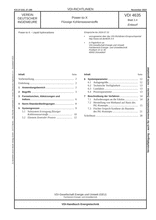Standards Worldwide
Standards Worldwide
Phone +49 30 58885700-07

Draft technical rule
VDI 4635 Blatt 3.4:2023-11 - Draft
Power-to-X - Liquid hydrocarbons
- German title
- Power-to-X - Flüssige Kohlenwasserstoffe
- Publication date
- 2023-11
- Original language
- German
- Pages
- 28
- Publication date
- 2023-11
- Original language
- German
- Pages
- 28
Product information on this site:
Quick delivery via download or delivery service
Buy securely with a credit card or pay upon receipt of invoice
All transactions are encrypted
Short description
The production of liquid hydrocarbons from renewable electrical energy and CO2 via so-called power-to-liquid (PtL) processes enables a switch to defossilized power, fuel and chemical feedstocks, even in those application areas that cannot be addressed via direct electrification. Coupling between the energy sector, which is increasingly based on renewable primary energy, and the heat, fuel, and chemical sectors thus makes it possible to avoid or at least reduce CO2 emissions in applications that continue to rely on the use of energy carriers with high energy density, while at the same time providing good storage and distribution infrastructure. In addition, PtL plants can also assume an important storage function in the future for volatile electrical energy from renewable sources such as wind or solar energy. As the share in the power grid continues to rise, storage options will be needed that are capable of storing large amounts of energy, even over longer periods of time, and feeding it back into the various sectors of the energy system as needed. For this purpose, liquid hydrocarbons are promising options due to their high volumetric and gravimetric energy density and generally very good storage stability and ease of handling. This standard applies to the synthesis of liquid hydrocarbons via methanol synthesis or the Fischer-Tropsch process as part of the PtX approach to electrical energy conversion and storage. In this standard, only those process chains are considered in which electrical energy is converted into liquid hydrocarbons as the main energy carrier. Accordingly, the starting points for the processes considered are hydrogen or synthesis gas, which are predominantly generated using regenerative electrical energy, and carbon dioxide.
Content
ICS
27.010,
27.190
Also available in
Loading recommended items...
Loading recommended items...
Loading recommended items...
Loading recommended items...
